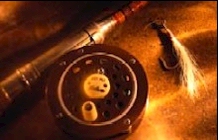|
Fly Fishing the rivers and lakes around Island Park is an experience that an angler
seldom forgets. The spring fed tributaries, creates an ideal situation for enjoyable and unparalleled fly fishing. Not only will you experience the exceptional fly fishing of
this area, but you are surrounded with the beauty of the Targhee National Forest, the wildlife and
history of people and the life they lived.
Few people
are fortunate enough to see this beautiful setting.
 |
The Henry's Fork of the Snake River runs through Island Park,
Idaho, which borders left of the nation's
oldest national park "Yellowstone". The Henry's Fork River
was a favorite to many
famous people like, Jack Hemmingway, President Theodore
Roosevelt, William Jennings Bryan and railroad magnate Roland
Harriman wrote, "It was a matter of love at first sight." The
Henry's Fork covers a stretch of roughly fifty miles, and it would take weeks
to fish all the good locations. The Henry's Fork originates
at the outlet of Henrys Lake which in own right is just as famous.
Henry's Lake is located south of the Montana border and under the Continental Divide. From the
lake's outlet to Big Springs is a major spawning area and closed to
fishing. The stretch between
Big Springs and Island Park Reservoir is good fishing but not near
the quality as below the reservoir.
Autumn
fishing on the North Fork, a favorite among seasoned
anglers.
 |
From the dam starts a fifteen
mile stretch in which the waters are labeled "Blue
Ribbon" and is catch and release only. The river's
character changes entering the Box Canyon stretch, as faster waters
and rapids come into play. Floating is probably the best method
to cover the stretch at least in June and early July. It's also a good
idea to sport some felt bottom shoes or cleated shoes as the footing
in this area can be very challenging. Because of the tumbling rapids, the
fish are more forgiving for the less than perfect presentation. I
would characterize this as fish living in the fast lane. It's
also a good time to utilize nymphs and streamers. Nymphs
consistently produce just as good fishing results as dries, if not
better.
Further down, below Last Chance on
into the Harriman Ranch, fishing takes on a different meaning and
demeanor. The Henry's Fork is wider with pockets and pools and flows much slower.
On the top it's flat and it may be a hundred yards before you see
a riffle. In this section the fish appear to have the upper
hand. They appear at times to hide in grass beds for what seems like
hours. It's also tough to match subtle insect hatches on top water in
places where tiny dry flies develop.
The calm waters
of Henry's Fork below Last Chance, reflecting a magnificent
sunset.
 |
This is probably why Andre
Puyans, who runs an exclusive fly fishing school on the river was
quoted as saying "Even the dumb fish in here have their
Ph.D.s". This stretch of Henry's Fork also brings some huge
bruts and it's quite common to catch a fish over twenty inches.
Many well experienced anglers recommend using a dry fly as an indicator with a small
nymph 16-20 inches below as a dropper.
To fish the ranch is at times is fishing blind. But there's not a better
feeling than catch a lunker, when your expectations were modest. Most of the stretch you can wade particularly in late summer and
fall. Fall is an excellent time to fish the Henry's Fork.
Crowds are gone and big fish are feeding steadily for the coming
winter.
Landing one of
these monsters on light tackle is a heart-thumping experience not
easily forgotten. If your a fly
fisherman, you owe it to yourself to fish the Henry's Fork river at
least once in your life.
Species: Rainbow,
Cutthroat, Brook
Hatches: Caddis, Stoneflies, Leadwing Olive, Gray Drake,
Brown Drake, Green Drake, Pale Morning Duns
Tackle & Gear:
For
most fishing on the Henry's
Fork an eight to nine foot, four or five-weight rod is a good
choice.
Season: Fishing season opens on Memorial Day and closes
at the end of November
|


